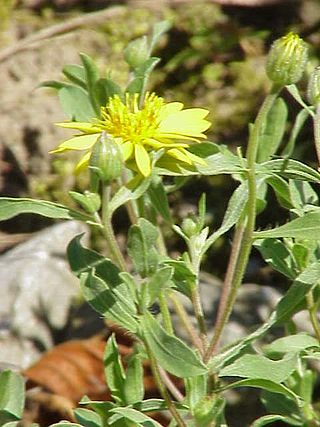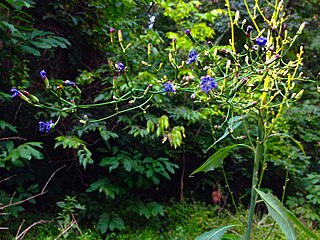
Heterotheca is a genus of North American plants in the family Asteraceae.

Grindelia camporum is a species of flowering plant in the daisy family known by the common names Great Valley gumplant and Great Valley gumweed.

Heterotheca grandiflora is a species of flowering plant in the family Asteraceae known by the common name silk-grass goldenaster or telegraphweed. It is native to the southwestern United States and northwestern Mexico, but it can be found in other areas as an introduced species, such as Hawaii. It is often a roadside weed even where it is native.
Heterotheca oregona is a species of flowering plant in the family Asteraceae known by the common name Oregon false goldenaster. It is native to the west coast of Canada and the United States in British Columbia, Washington, Oregon, and California as far south as Los Angeles County.

Heterotheca sessiliflora is a species of flowering plant in the family Asteraceae known by the common name sessileflower false goldenaster. It is native to California, Sonora, and Baja California.

Holocarpha heermannii is a species of flowering plant in the family Asteraceae known by the common name Heermann's tarweed. It is endemic to California.

Heterotheca shevockii is a rare species of flowering plant in the family Asteraceae known by the common names Kern Canyon false goldenaster and Shevock's goldenaster. It is endemic to California in the United States, where it is known only from Kern County. It grows along a 21-mile stretch of the Kern River.

Doellingeria infirma, the cornel-leaf whitetop or cornel-leaved aster, is a perennial forb native to the eastern United States, that produces white composite flowers in late summer.

Bigelowia nudata, the pineland rayless goldenrod, is a species of North American flowering plant in the family Asteraceae. It is native to the coastal plain of the southeastern United States.

Bradburia pilosa, the soft goldenaster, is a North American species of flowering plants in the family Asteraceae, native to the south-central United States, primarily the southeastern Great Plains and lower Mississippi Valley, in the states of Texas, Oklahoma, Kansas, Missouri, Arkansas, Louisiana, Tennessee, Mississippi, and Alabama. Additional populations are reported farther east but these appear to be introductions. Its habitats include disturbed roadsides and pine-oak-juniper woods.
Erigeron elatus is a North American species of flowering plants in the family Asteraceae known by the common names swamp fleabane and swamp boreal-daisy.

Erigeron vreelandii is a North American species of flowering plant in the family Asteraceae known by the common names sticky tall fleabane and Vreeland's erigeron. It grows in northwestern Mexico and in the southwestern United States.
Eucephalus glabratus is a North American species of flowering plant in the family Asteraceae with the common names of smooth aster, smooth wayside-aster, and Siskiyou aster. It is a perennial herb up to 60 centimeters tall, with branching rhizomes. Stems and leaves are hairless or nearly so. One plant will usually produce 3–8 flower heads per stem. Each head has 0–4 violet ray florets surrounding numerous yellow disc florets.

Euthamia leptocephala, the bushy goldentop or Mississippi Valley goldentop, is a North American species of plants in the family Asteraceae. It is native to the south-central United States, in the lower Mississippi Valley and the Coastal Plain of the Gulf of Mexico, from Texas to west-central Georgia and north as far as southern Illinois.

Heterotheca subaxillaris, known by the common name camphorweed, is a North American species of flowering plant in the family Asteraceae. It is widespread across much of the United States as well as Mexico and Belize.
Heterotheca fulcrata, known by the common name rockyscree false goldenaster, is a North American species of flowering plant in the family Asteraceae. It has been found in northern Mexico and in the western United States.

Heterotheca rutteri, the Huachuca goldenaster or Rutter's false goldenaster, is a rare North American species of flowering plant in the family Asteraceae. It has been found only in the Huachuca and Santa Rita Mountains of southern Arizona and northern Sonora.

Heterotheca villosa, commonly known as the hairy goldenaster, is a species of flowering plant in the family Asteraceae found in central and western North America.

Lactuca floridana, commonly known as woodland lettuce, Florida lettuce, or false lettuce is a North American species of wild lettuce. It is native across much of central Canada and the eastern and central United States.

Symphyotrichum divaricatum is an annual and herbaceous plant commonly known as southern annual saltmarsh aster. It is native to the southern United States and some northern states of Mexico.
















